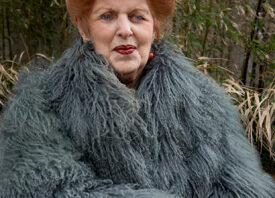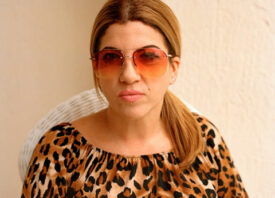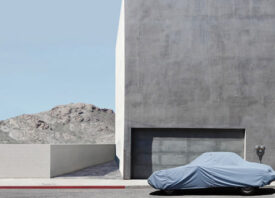Search this site
One Young Photographer on Reshaping the World Through Powerful Images (Sponsored)

Born and raised in Harlem, New York, Flo Ngala has always had creativity running through her veins. She found her voice early on by staging self-portraits in her bedroom and documenting her community on her daily route to and from school, and since then, she’s used her talents to amplify the voices of others. As a photographer for some of the biggest names in the music and fashion industries, she’s helped shape modern popular culture, while at the same time staying true to her candid, authentic aesthetic and interest in telling real, human stories.
Ngala’s skills have taken her to unexpected destinations, figuratively and literally; in 2016, she jetted off to Senegal to shoot a fashion editorial, and she’s been traveling on assignments ever since. When she’s not behind the lens herself, Ngala’s still immersed in the world of images; she’s interned at one of the biggest ad agencies in the world and plans to continue art directing. Oh, and she just celebrated her 23rd birthday this spring.
As she’s grown from an ambitious teenager into fully-realized creative force, Ngala has continued to approach every new project with the same passion and ingenuity that fueled her early work. When the time came for the photographer to create a website, Squarespace was the obvious choice. Their DIY website builder allowed her to showcase her work beautifully, without any hassle.
Featuring slideshows of images from her documentary projects, behind-the-scenes celebrity shoots, and self-portrait sessions, Ngala’s website puts powerful photography front and center. The final piece of the puzzle was claiming this online space with a domain name of her own. “Typing flongala.com into a browser still is so cool to me,” she says. We asked her to tell us more about website design, the photo industry, and the importance of impactful imagery.

You have a powerful social media presence, and you’ve expanded that online presence with your website. Why was it important to you to build this home-base for your brand and your projects, outside of your social channels?
“I remember when I first made a Squarespace website. It almost felt like a rite of passage. It was important to me to expand my brand this way. I knew that social media was one thing, but having a tangible URL with my name and my work attached to it would be a step into the professional world. I had been using other social channels to share my work, but at some point, I was like, ‘Okay, time to invest in displaying my work on a more professional level.’ To me, that meant getting a website, specifically getting a Squarespace website.”
Why did you choose Squarespace?
“The design. I love the design of Squarespace, and the layouts were seamless and easy-to-use. When I was doing research, I paid attention to what other artists were using as well, and most people were on Squarespace. I wanted something that gave me a light feel but allowed my images to resonate in a heavy way and really speak for themselves.”
You’re busy, so convenience must have been a big factor while creating your site. What did the actual process of building your website look like?
“I’m incredibly indecisive, so at first, I just put in all of the work that I liked. After that, I played with different templates. The biggest thing for me was figuring out ways to get people to stay on the site and look at everything I thought was cool. I wanted to lead them visually from one tab or link to the next.
“I shot this photo series in my neighborhood one summer and sent the images to a Photo Editor at the New York Times Magazine. She looked through my site and invited me to her office to chat. We went through my site, and she basically was like, “You need to take down 60% of this. It’s too much.” She was right. Less is more. That was really big for me, and it had me thinking about the way people take in my work. Was I really portraying it in the most efficient way? How could I use the pages and galleries that Squarespace offered to best curate my images? Still a work in progress, but we’re getting there!”
Looking at your website, it’s immediately clear that you’re a photographer. It’s all about the images! What template did you choose?
“I’ve been using Wells for the longest!”
What has been the most rewarding experience that’s come from creating your website?
“Seeing how some of my images lead people back to discover my other work. For example, I took a photo at D.C.’s Broccoli Fest in April, and it went viral. Traffic to my site increased as people began to probe for who captured the image. Leading publications proceeded to email me asking for permission to share it. It was awesome. I also just get excited anytime I get an email where someone mentions they’ve been on my site.”

You became a photographer at just 14 years old! What do you think has changed for your generation of photographers?
“When I was first learning about photography, I remember developing film, making selects, printing, and reprinting images. It was truly a process. I was lucky if I could get everything done in one class period. Now, memory cards let you send pictures right from your camera to your phone. You can take a photo on your phone, and with the right editing, it’s hard to even tell it wasn’t taken on a DSLR camera. The rules have changed!
“Our generation now has the advantage of creating at a much faster rate, but I’d argue that this is both an advantage and a huge challenge for us. People get excited to share their work, and, in my opinion, the quickness of it all keeps people from putting out their strongest art. There’s less curating and storytelling with images. Things feel less intentional and sometimes have less depth. I hate to admit I’m guilty of this as well.
“On the flip side, a digital age means networking like we’ve never seen before— it sometimes just takes an email, a viral image, a website click, or a well-written DM to change the trajectory of someone’s career. The digital age has really allowed artists to step out on to a world stage.”
You got your start in self-portraiture, and you’ve been compared to photographers like Samuel Fosso and Zanele Muholi. How did that process help shape your understanding of yourself?
“I really believe all photographers should take self-portraits. To know your camera is to know yourself. My camera is an extension of who I am and how I see the world. It’s become a sixth sense and an extra muscle I get to flex.
“A photograph reflects the photographer, their perception of the world, and their relationship with their subjects. Self-portraits helped me to understand what I loved about myself and how I liked to be photographed. They helped me to understand what I thought was strong about me on a particular day or year.
“Understanding the best way to shoot pushed me to become a better artist, and it was the best form of trial and error I could have ever taken up. From an artistic standpoint, what I liked most about my self-portraits is that they helped me to discover what I valued in my images of others as well. For example, I’m really into color and composition. I love good light. I’m also into expressions, and that’s important to me.”
What do you look for when you accept an assignment, whether it’s from a record company, a fashion designer, or any other brand? What makes a potential client stand out to you?
“When it comes to music, I think now I just get excited to be asked to shoot certain things like listening parties, events, etc. I love being around artists and the energy in those environments. I usually meet a lot of great people as well.
“When it comes to fashion or similar work, I go with my initial gut reaction or try to think through something creatively. I’ve gotten very good at this over the years! My eye has improved, and it feels more natural to make those decisions.
“This might be redundant, but in potential clients, I love seeing potential. I get most excited when I see someone who I think has a strong look but just needs the right imagery to go with that. I get excited about talent and finding talent; my favorite thing lately has been trying to work with people who have great potential or maybe a vision worth investing in, but just need someone to help them execute it.”
How do you think artists in this generation— and especially in this political climate— can use their creativity to spark change?
“By finding where their passions for art and politics overlap and then making the commitment to create from that place. We’re all residents of this planet, seeing and hearing a lot of the same news, good or bad, but we all interpret things differently. I’d say sparking change is simply deciding to do the work you’re already doing as an artist but just taking it a step further. This sometimes proves to be the most powerful.
“Take Shepard Fairey’s iconic Obama Hope image. He had already been creating in that style for years, but this fusion with his political beliefs and support of the then president-elect inspired people in ways that a news article on Obama or TV interview may not have. Creativity gives us different ways to articulate ideas. That’s something this generation, myself included, needs to take the reins on. Also, shout out to the individuals already using their platforms and talents to do this while the rest of us play catch-up.”
Tell us a bit about diversity and representation in the photography industry in particular.
“It excites me to see some of the young photographers behind images of big artists. I follow a few celebrity photographers on Instagram, and I am constantly inspired. Seeing young people of color behind the lens, creating images of these artists of color, is exciting to me. That’s something I consider a positive step. I would love to see more female shooters in the music industry, for sure. We coming, tho!”

You’ve also worked in advertising. Has that influenced your understanding of the power of images at all?
“Definitely, and I’m still delving into advertising, so as time goes on, I’ll have more to say about this too. But for now, my experiences in the past year as an intern at two agencies has put the phrase ‘pictures are worth a thousand words’ at the forefront of my brain. My ultimate goal is to be a creative director/consultant and a photographer/video director, so experiencing those simultaneously on a micro level now has given me great perspective.
“One example is that, during my last internship at an agency called Droga5, I assisted these super cool Creative Directors with image searching on a pitch. I found myself with like 50 tabs open at a time, grabbing lots of photos for reference. Since the CDs had a specific look and feel in mind, they’d approve very few of the images, and I’d resume my research. This was simply because they were super keen on what was to be presented. They knew these details could make or break the client liking the photos. Even as a photographer, ‘the edit’ is so important. You can have a terrible shoot, but if you pick the right images, no one would even know. I’m advertising myself every day with my work. I think I’m doing an okay job.”
Looking back on the last nine years, what’s the biggest piece of advice you’d want to give your younger self? Any words of wisdom for young and emerging photographers?
“Be patient. Timing is everything. At a younger age, I was very anxious and excited about my work. I felt that, because I was so filled with the passion and the energy to succeed, I deserved to be working on a more professional level. I really wanted to be taken seriously. Now, I live by an ‘everything happens for a reason’ mentality. Things happen when they’re meant to. I tell people to focus on being the best you can be at your craft, so when your time does come to shine, you come super correct.”
You can try Squarespace free for 14 days. When you’re ready to subscribe, be sure to use coupon ‘FEATURESHOOT’ for 10% off your first purchase.
Squarespace is a Feature Shoot sponsor.


